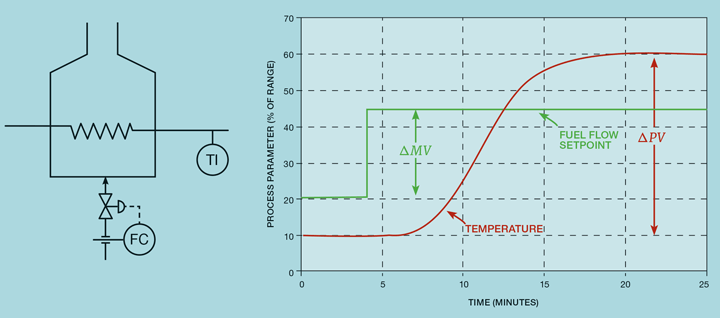Practical Process Control Part 2: Determining Process Dynamics
Myke King continues his detailed series on process control, seeking to inspire chemical engineers to exploit untapped opportunities for improvement
IDENTIFYING process dynamics is an essential first step to achieving good control design. Many control engineers will be guilty of spending many hours tuning controllers by trial and error. This can largely be avoided. Using the process dynamics, obtained from straightforward plant testing, simple calculations can then be applied to identify optimum tuning for all types of controller.
So, imagine that you’re the first into the bathroom in the morning and you turn on the hot tap. Initially it produces cold water and does so for some time. We anticipate this behaviour; the water, held up between the source of hot water and the tap, has had time to cool to room temperature. This water first has to be displaced. It has to be transported to the tap and causes what we describe as a transport delay. Also known as deadtime (θ), it is the first of the dynamic constants that we use to describe process behaviour. We also notice that, when the cold water has been displaced, the water temperature doesn’t immediately increase to that of the hot water; it ramps up to it. Part of the energy in the water is required to warm up the pipework leading to the tap. The process is said to have capacity, in this case thermal capacity. It is responsible for the second of our dynamic parameters which we describe as lag (τ). The water temperature has changed from cold to hot, from one steady state to another. We describe this difference as the steady state change.
Process gain
Now we must leave the analogy because we can’t use the opening of the tap to actually control the temperature. We’ll consider instead the fired heater shown in Figure 1. It has a flow controller (FC) installed on the fuel supply and temperature indicator (TI) on the product outlet. Our intent is to install a temperature controller that will adjust the fuel flow. To design this controller we first determine the process dynamics. We make a step change to the FC set-point. The temperature shows much the same response as our bathroom tap. The TI is located downstream of the firebox and so exhibits transport delay. The heating coil, and the fluid it contains, have significant capacity to absorb heat; so we also see lag.

The final, and most important parameter, is the process gain (Kp). This is defined as the steady state change in temperature, our process variable (PV), divided by the steady state change in fuel flow set-point, our manipulated variable (MV).

We need to be careful with units. The process gain, as we’ll see in a future article on tuning, is largely used to determine the controller gain (Kc). We’ll see that controllers installed in programmable logic controllers (PLC) or distributed control systems (DCS) work in dimensionless form. Kc must be dimensionless and so, therefore, must Kp. To make both PV and MV dimensionless; we divide each by its corresponding range (or span). The instrument ranges for the TI and FC will have been assigned by the instrument engineer as part of the control system configuration. They usually remain constant. (The need to retune the controller, if the instrument ranges are ever changed, is frequently overlooked.)

Note that control applications, like multivariable predictive controllers (MPC), residing at the computer level generally operate in engineering units. For these applications, Kp should not be converted to its dimensionless form. Numerically Kp can be positive or negative, even zero in very unusual circumstances. In our example of the fired heater, increasing fuel increases the temperature and so the process gain is positive. If we were planning to control the temperature of a cooler by manipulating the flow of cooling water, the process gain would be negative. The choice of instrument ranges will often result in Kp being close to 1 but there can be occasions where it differs by several orders of magnitude.
Recent Editions
Catch up on the latest news, views and jobs from The Chemical Engineer. Below are the four latest issues. View a wider selection of the archive from within the Magazine section of this site.




